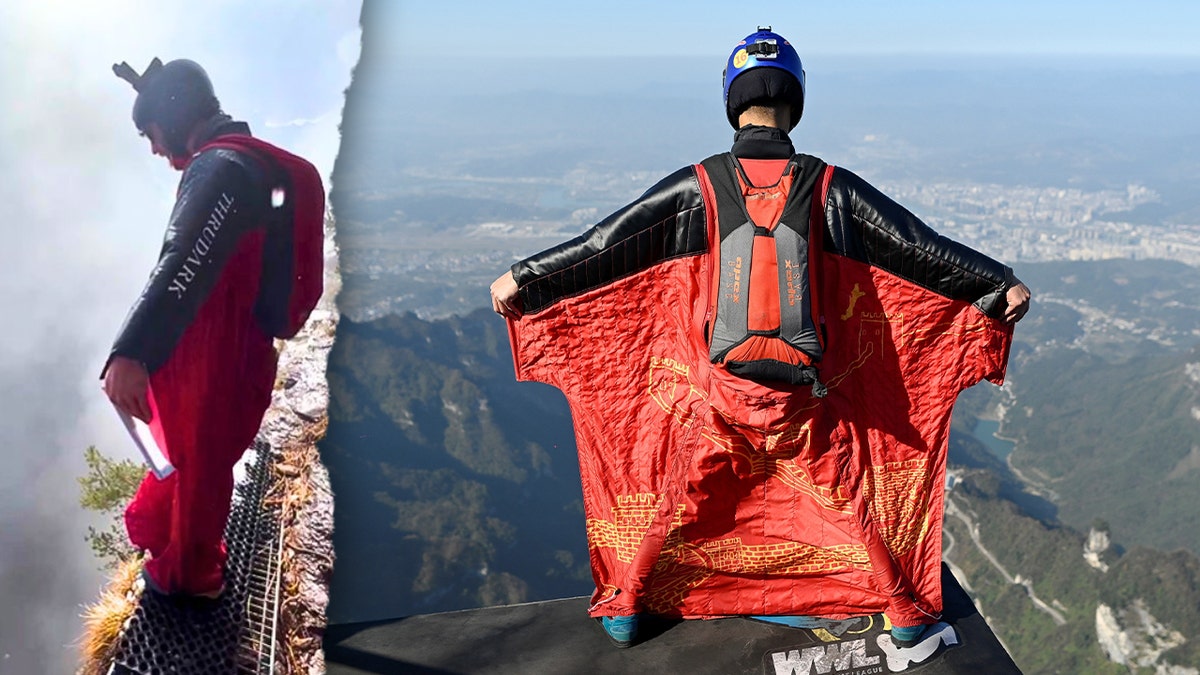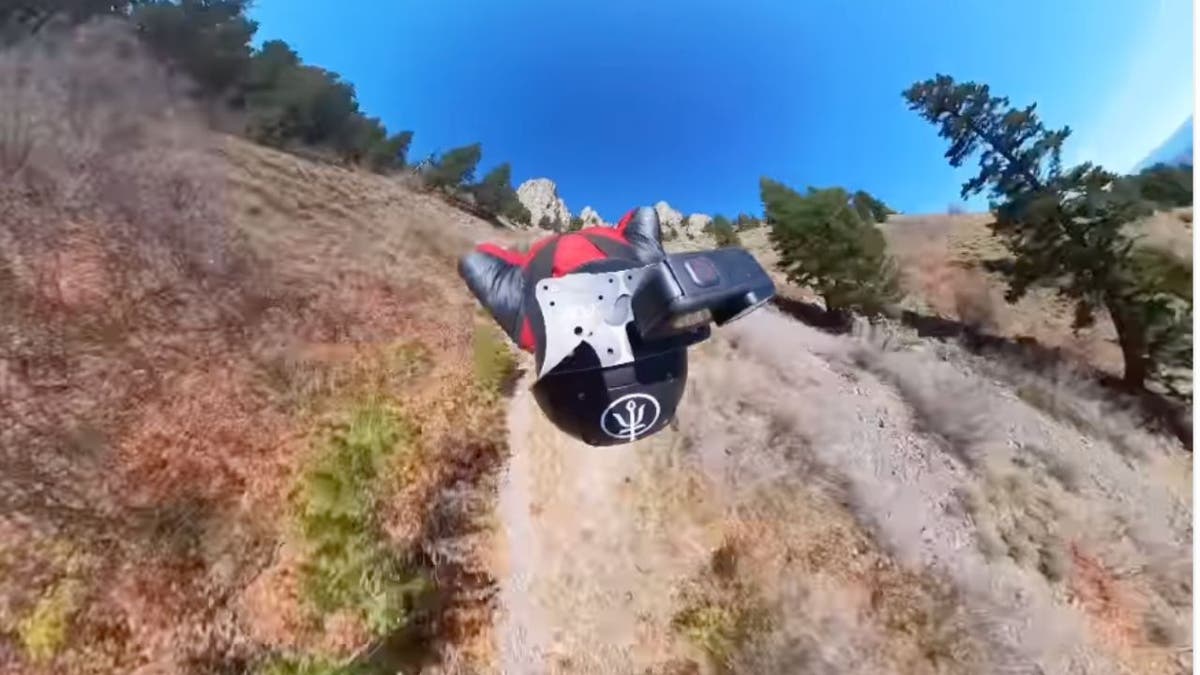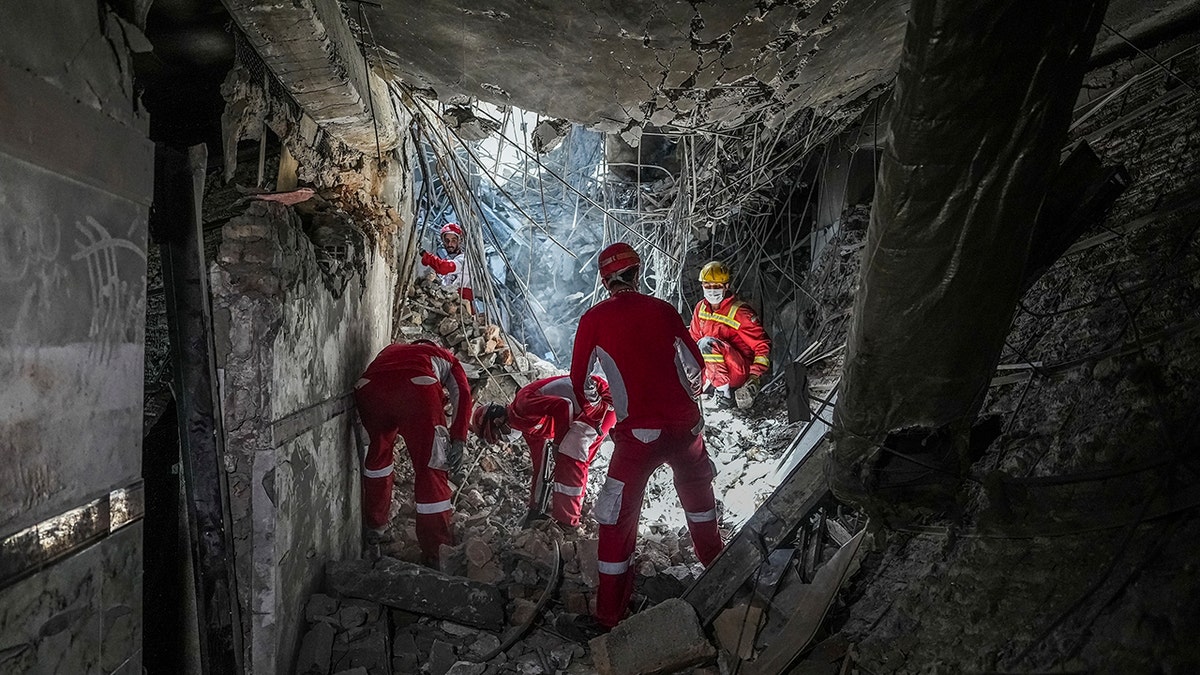INTERNACIONAL
Champion skydiver plummets to death during wingsuit jump

NEWYou can now listen to Fox News articles!
A champion wingsuit flyer who featured in a BBC documentary called The Boy Who Can Fly has died after he was critically injured in a jump over the weekend.
Liam Byrne, 24, was taking part in a high-risk jump at nearly 8,000 feet above sea level in the Swiss Alps on Saturday when tragedy struck, according to The Telegraph, citing local police.
Byrne, of Scotland, was wearing a wingsuit, a specialized webbed-sleeved jumpsuit with membranes between the arms, body and legs which allows a diver to glide flight in the air.
Wingsuit diver Liam Byrne in action and smiling in a collage. He died on Saturday. (Instagram @liambyrne0)
COLORADO SKYDIVER FALLS TO HIS DEATH IN FREAK ACCIDENT
He was one of three wingsuit pilots who launched a jump from Gitschen, a mountain overlooking Lake Lucerne in Switzerland.
However, Byrne «deviated from his intended course shortly after take-off for reasons still unknown and crashed into a rocky outcrop,» police said. «He suffered fatal injuries.»
Byrne, a British champion in the adrenaline-fueled sport, was an experienced flyer with more than 4,000 jumps to his name, according to the outlet. His Instagram account also lists him as a skydiving instructor, wingsuit coach and BASE (Building, Antenna, Span and Earth) jumper.
In the BBC-produced documentary, filmmakers follow Byrne’s journey to champion flyer.
Byrne told the documentary: «I think I was about 13 when I said to my dad that I wanted to learn to fly like a bird.»

Byrne getting ready to jump, left, a man in a wingsuit on Tianmen mountain in Zhangjiajie, China’s Hunan province, showing his full suit. (Instagram @liambyrne0; WANG ZHAO/AFP via Getty Images.)
FRENCH PILOT OF PLANE THAT DECAPITATED SKYDIVER FOUND GUILTY OF MANSLAUGHTER
He said that an office job scared him far more than the fear of dying from a base or wingsuit jump. He insisted that good preparation was at the heart of all his jumps and kept him safe and acknowledged that the high-risk sport worried his family.
Byrne climbed Mount Kilimanjaro at age 12, became a licensed paraglider at 14, completed his first skydive at 16 and was flying in a wingsuit by 18, according to the BBC.
Byrne’s family released a statement praising him and saying that the sport was «more than just a thrill for Liam – it was freedom. It was where he felt most alive.»
«We would like to remember Liam not just for the way he left this world, but for how he lived in it,» the statement reads in part.

Liam Byrne in the last wingsuit jump he posted to Instagram. (Instagram @liambyrne0)
CLICK HERE TO GET THE FOX NEWS APP
«Liam was fearless, not necessarily because he wasn’t afraid but because he refused to let fear hold him back. He chased life in a way that most of us only dream of and he soared.»
The statement continued: «He inspired all of us and made life better with his bold spirit and kind heart. We will miss Liam’s wild energy and contagious laugh. Though he has now flown beyond our reach, he will always be with us.»
There have been a number of wingsuit-related deaths in the U.S., including a January 2024 incident in which Gregory Coates, 36, died in Colorado after both his primary and reserve parachutes failed to deploy.
In September, Jonathan Bizilia, 27, of Alabama died in a jump in Utah.
INTERNACIONAL
House Republicans warn anti-ICE rhetoric from Democrats is driving violent attacks on agents

NEWYou can now listen to Fox News articles!
President Donald Trump’s crackdown on illegal immigration and deportation rollout has ignited anti-Immigration and Customs Enforcement (ICE) protests across the United States.
House Republicans told Fox News Digital there is a parallel between Democrats’ rhetoric against federal immigration officers amid this crackdown and the surge in violence against ICE and Border Protection (CBP) officers.
«The increasingly violent attacks against law enforcement are being egged on by irresponsible Democratic politicians,» Rep. Tom McClintock, R-Calif., said in an exclusive interview.
Department of Homeland Security (DHS) Secretary Kristi Noem on Monday blamed Democrats’ «sanctuary city policies» for the shooting of an off-duty CBP officer in New York City.
NOEM WARNS OF ‘UNPRECEDENTED’ THREAT LEVEL FOR ICE AGENTS, BLAMES ‘LIES’ FROM DEMOCRATS
A split image of demonstrators in New York City protesting the Trump administration’s use of the Alien Enemies Act to more quickly deport certain migrants from the U.S. to El Salvador, alongside a photo of U.S. President Donald Trump at the White House in 2025. (Getty Images)
A second illegal immigrant has been apprehended in connection to the shooting of the CBP officer. He was reportedly struck in the face and forearm in Manhattan’s Riverside Park on Saturday night. Miguel Francisco Mora Nunez, a Dominican national who was caught by Border Patrol in April 2023, was taken into custody following the shooting.
GUNMAN AMBUSHES BORDER PATROL AGENTS DAYS AFTER HOUSE DEMS REJECT RESOLUTION CONDEMNING ANTI-ICE VIOLENCE
«Without enforcing our immigration laws, we have no immigration laws,» McClintock continued. «Without immigration laws, we have no border, and without a border we have no country. And that’s what Americans suffered for four long years with the open borders policies of the Biden administration.»
Democrat Sens. Alex Padilla and Cory Booker, two of the leading Capitol Hill critics of Trump’s illegal immigration crackdown, have introduced legislation that would require immigration enforcement officers to clearly identify themselves without masks.
Rep. Andrew Clyde, R-Ga, told Fox News Digital that he has «absolutely» seen an increase in violence, explaining that when a member of Congress uses «radical rhetoric,» people take it to heart.

US soldiers seen at the US-Mexican border in New Mexico on May 8, 2025. (Can Hasasu/Anadolu via Getty Images)
«We should be applauding them. We should be thankful to them. They are literally removing criminal aliens from our midst and making us a safer nation. And yet these radical Democrats are inflaming the public. And as a result, you’re seeing more violence against them. And it’s unconscionable that they do that,» Clyde said.
Federal immigration law enforcement officers have been targeted since Trump signed his «big, beautiful bill» into law, which includes legislation for robust immigration reform. There were at least two ambushes in Texas, and protesters clashed with federal officers at the Portland, Oregon, ICE facility, over the Fourth of July weekend.
Rep. Michael Guest, R-Miss., told Fox News Digital that there has been «growing rhetoric by many on the Democratic side» from everyone except Sen. John Fetterman, D-Pa. Particularly in Los Angeles, Guest pointed to California Gov. Gavin Newsom’s and Mayor Karen Bass’ anti-ICE rhetoric as protests delved into riots in the West Coast city last month.

Immigration and Customs Enforcement (ICE) agents, along with other federal law enforcement agencies, attend a pre-enforcement meeting in Chicago on Jan. 26, 2025. (Christopher Dilts/Bloomberg via Getty Images)
Bass has signed a series of executive orders aimed at impeding ICE deportation raids in Los Angeles, criticizing the «unconstitutional, reckless raids» and establishing a Los Angeles Police Department (LAPD) working group that expands resources for families impacted by Trump’s deportation rollout.
«When we have Democrats constantly attacking our ICE agents for what they’re doing, demonizing them for enforcing the law, that is going to create more violence, and the situation is going to get worse and not better,» Guest added.
Rep. Mariannette Miller‑Meeks, R‑Iowa, added in an interview with Fox News Digital that it’s «unreal to me that people are attacking law enforcement agents trying to do their job.»
CLICK HERE TO GET THE FOX NEWS APP
She said the emphasis should be on supporting ICE and CBP agents.
«Keep the focus on deporting criminal illegals, people that are bad actors that should be out of the country, focusing on the influence of gangs and cartels in this country,» Miller-Meeks added, urging her fellow House Republicans to remind Americans that these deportations are necessary due to the surge of illegal immigration under the Biden administration.
Fox News Digital reached out to Biden’s office for comment but did not immediately hear back.
INTERNACIONAL
27 inmates from notorious Iranian prison still at large after Israeli strike: Tehran

NEWYou can now listen to Fox News articles!
Iranian media reported that 27 inmates from the notorious Evin Prison remain at large following an Israeli airstrike last month.
After Israel’s strike during the 12-day war, 75 inmates escaped from Evin prison, according to the Associated Press, which cited a news website affiliated with Iran’s judiciary. In the article, Iranian Judiciary Spokesperson Asghar Jahangir said that out of the 75 escapees, 48 were either recaptured or returned voluntarily, the Associated Press added. Jahangir also stated that the escapees had been serving time for minor offenses.
A view shows the aftermath of an Israeli strike on Evin Prison that took place on June 23, after the ceasefire between Israel and Iran, in Tehran, Iran, June 29, 2025. (Majid Asgaripour/WANA (West Asia News Agency) via REUTERS)
IRAN CLAIMS ITS PRESIDENT WAS INJURED IN ISRAELI AIRSTRIKE LAST MONTH
In June, Israel launched Operation Rising Lion, which was aimed at destroying Iran’s nuclear capabilities. While Iranian officials said 71 were killed in the strike, local media reported that there were 80 killed, including staff, soldiers, inmates and visiting family members, according to the Associated Press.
Sayeh Seydal, a jailed Iranian dissident who survived Israel’s strike on Evin Prison, told relatives that being in the facility was a «slow death,» according to the Associated Press, which obtained a recording of the conversation.
«The bombing by the U.S. and Israel didn’t kill us. Then the Islamic Republic brought us to a place that will practically kill us,» Seydal said.
On Tuesday, Amnesty International called for an investigation of Israel’s strike on the prison as a possible war crime, saying it constituted «a serious violation of international humanitarian law.»

FILE – Rescuers search through the rubble of a damaged section of Evin Prison following an Israeli strike the day before, in Tehran, Iran, Tuesday, June 24, 2025. (AP Photo/Mostafa Roudaki/Mizan News Agency, File) (AP Photo/Mostafa Roudaki/Mizan News Agency, File)
IRAN ACKNOWLEDGES DEATH TOLL FROM ISRAEL’S STRIKE ON NOTORIOUS EVIN PRISON
Erika Guevara Rosas, who serves as Amnesty International’s Senior Director for research, advocacy, policy and campaigns, said «the evidence establishes reasonable grounds to believe that the Israeli military brazenly and deliberately attacked civilian buildings.»
Evin Prison is infamous for its harsh conditions and became a place for Iranian officials to throw protesters.

A person stands on the rubble as a view shows the aftermath of an Israeli strike on Evin Prison that took place on June 23, after the ceasefire between Israel and Iran, in Tehran, Iran, June 29, 2025. (Majid Asgaripour/WANA (West Asia News Agency) via Reuters)
CLICK HERE TO GET THE FOX NEWS APP
In 2022, the U.S. Treasury Department sanctioned Iranian officials and entities responsible for a crackdown on protesters, including Evin Prison warden Hedayat Farzadi, who was known for his brutal tactics. The department said that protesters thrown in Evin Prison under Farzadi’s watch were subjected to torture and physical abuse.
INTERNACIONAL
Israel extiende su ofensiva y la Unión Europea eleva el tono: «Matar a civiles que buscan ayuda en Gaza es algo indefendible»

«Noche de terror»
Evacuaciones forzadas
Israel,Franja de Gaza,Hamas

 POLITICA3 días ago
POLITICA3 días agoJuan Carlos Maqueda defendió la condena contra Cristina Kirchner: “Hay una sensación de que se hizo Justicia y que no hay impunidad”

 POLITICA2 días ago
POLITICA2 días agoExpulsada del Gobierno, Victoria Villarruel empieza a tomar distancia, pero no tiene proyecto político para este año

 POLITICA2 días ago
POLITICA2 días agoLa CGT evalúa adelantar a octubre el recambio de sus autoridades y define una movilización contra Milei

























